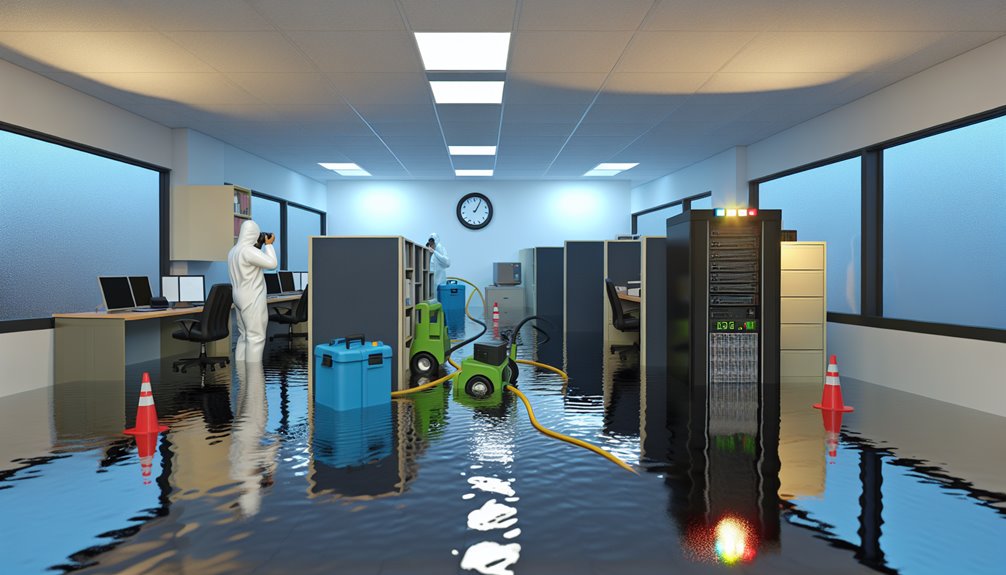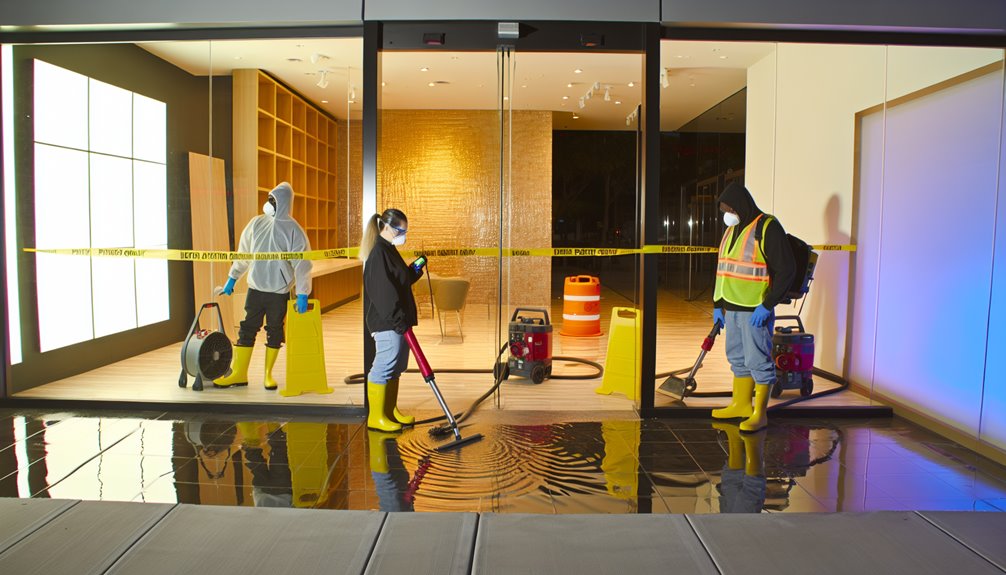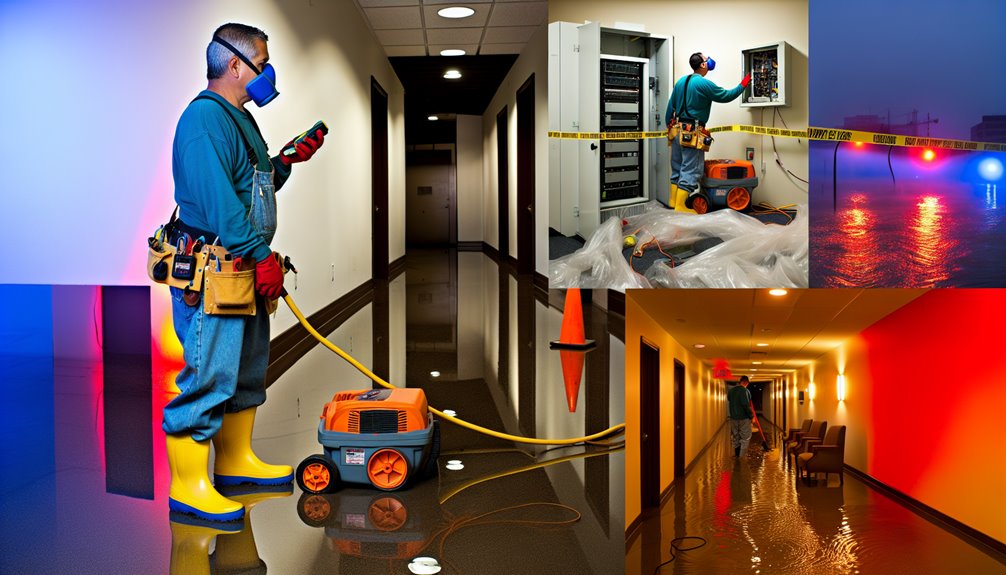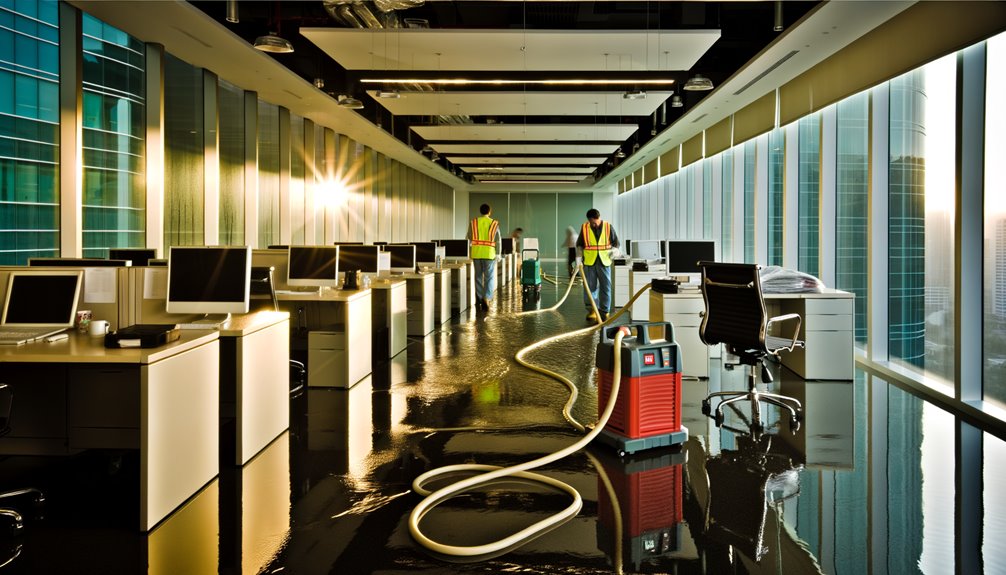When water hits your facility, every minute costs you—on average, 40% of businesses never reopen after major loss events. You can cut downtime by 30–50% with a pre-planned response: shut utilities, document conditions, extract water, and stage dehumidifiers within the first hour. Coordinated vendors and clear roles limit mold growth (24–48 hours) and electrical hazards. If you want your insurance claim approved faster and revenue protected, here’s what to do next.
Immediate Actions in the First Hour After Water Damage

Before mold starts within 24–48 hours and costs escalate by 20–30% per day of delay, act fast: shut off the main water supply and electricity to affected zones, document damage with time‑stamped photos, and prioritize safety (avoid standing water near outlets and slippery surfaces). Verify shutoff procedures at valves, breakers, and any branch lines. Establish interim containment: close doors, deploy plastic sheeting, and place absorbent barriers to stop migration. Elevate inventory and electronics above wet floors. Record moisture readings at floor, baseboard, and wall cavity. Begin extraction with wet vacs, then promote airflow using fans and dehumidifiers. Label hazards and communicate access restrictions.
Coordinating a Rapid-Response Restoration Team
Kick off coordination within 15 minutes by activating a pre-vetted restoration roster and a clear incident command structure (IC/Ops/Logistics/Safety). Assign roles, set objectives, and time-box tasks. Use documented communication protocols: one channel for status, one for decisions, one for vendor coordination. Your vendor vetting should confirm 24/7 availability, IICRC certifications, proof of insurance, and mobilization time under 60 minutes.
Deploy triage: extraction, critical asset protection, and dehumidification. Track KPIs—arrival times, pump rates (gpm), moisture readings, and drying curves—every 60 minutes. Document costs in real time to control spend and accelerate claims. Debrief daily; refine rosters and workflows for continual improvement.
Safety Protocols to Protect Staff and Customers

Although speed matters, safety dictates every move during water restoration. You protect people first, then property. Lock out electricity, isolate wet zones, and verify air quality before reentry. Enforce PPE training so every employee knows when to don respirators, gloves, and boots; OSHA data shows proper PPE cuts injury risk by over 60%. Post clear evacuation routes and rehearse them quarterly; drills reduce exit time by 30–50%. Assign a safety lead to monitor slip, mold, and biohazard risks, and document daily briefings.
- You safeguard livelihoods.
- You calm fear with order.
- You turn chaos into care.
- You bring everyone home.
Documentation and Evidence for a Strong Insurance Claim
When water hits your business, build your claim file from minute one to shorten payouts and prevent disputes. Capture a time-stamped photo inventory of every affected area, asset, and serial number. Log moisture readings, square footage impacted, and hours lost; insurers pay faster when you quantify loss. Save invoices, drying logs, and chain-of-custody notes for removed materials. Secure written contractor estimates within 24 hours, then align them with your policy’s coverage limits and deductibles. Record all adjuster communications. Back up files in two locations. Share a concise summary: cause, timeline, mitigation steps, costs, and downtime. Accurate documentation protects people and operations.
Preventing Secondary Damage: Mold, Electrical, and Structural Risks

Strong documentation sets you up to act fast, and speed is the difference between a clean recovery and compounding loss. Within 24–48 hours, unchecked moisture can trigger mold growth, short circuits, and weakened framing. Prioritize moisture mapping, immediate extraction, targeted drying, and prompt electrical inspection to protect staff, assets, and service continuity. Schedule certified mold remediation if air or surface tests indicate elevated spore counts. Reinforce load-bearing elements once materials hit safe moisture levels.
- Lives and livelihoods depend on your decisiveness—act now.
- Don’t let invisible moisture sabotage your mission.
- Protect teams who trust your leadership.
- Safeguard the community you serve.
Building a Resilient Water Emergency Plan for Your Business
Because water incidents escalate in hours, not days, you need a documented, drill-tested water emergency plan that defines roles, thresholds, and actions by the minute. Map shutoffs, backup power, and data priorities. Assign on-call leaders, alternates, and communications channels. Schedule quarterly Emergency drills; time your response and cut-offs, then fix gaps. Preauthorize Vendor contracts for mitigation, drying, and electrical safety with 24/7 SLAs and arrival-time guarantees. Keep a go-kit: floor plans, contact lists, PPE, moisture meters. Set trigger thresholds (gallons, areas affected) that auto-activate tasks. Train vendors and staff together. Audit annually. Your speed protects people, assets, and service continuity.
Conclusion
At Hydra Clean, we understand that dealing with water damage can be overwhelming, but you don’t have to face it alone. Our team is dedicated to helping you restore your business quickly and efficiently, ensuring minimal disruption and loss. If you want to learn more about our water restoration services or have any questions, please don’t hesitate to reach out. Visit us at myhydraclean.com or give us a call at (601) 336-2411. We’re here to support you every step of the way, and together, we can get your business back on track.

